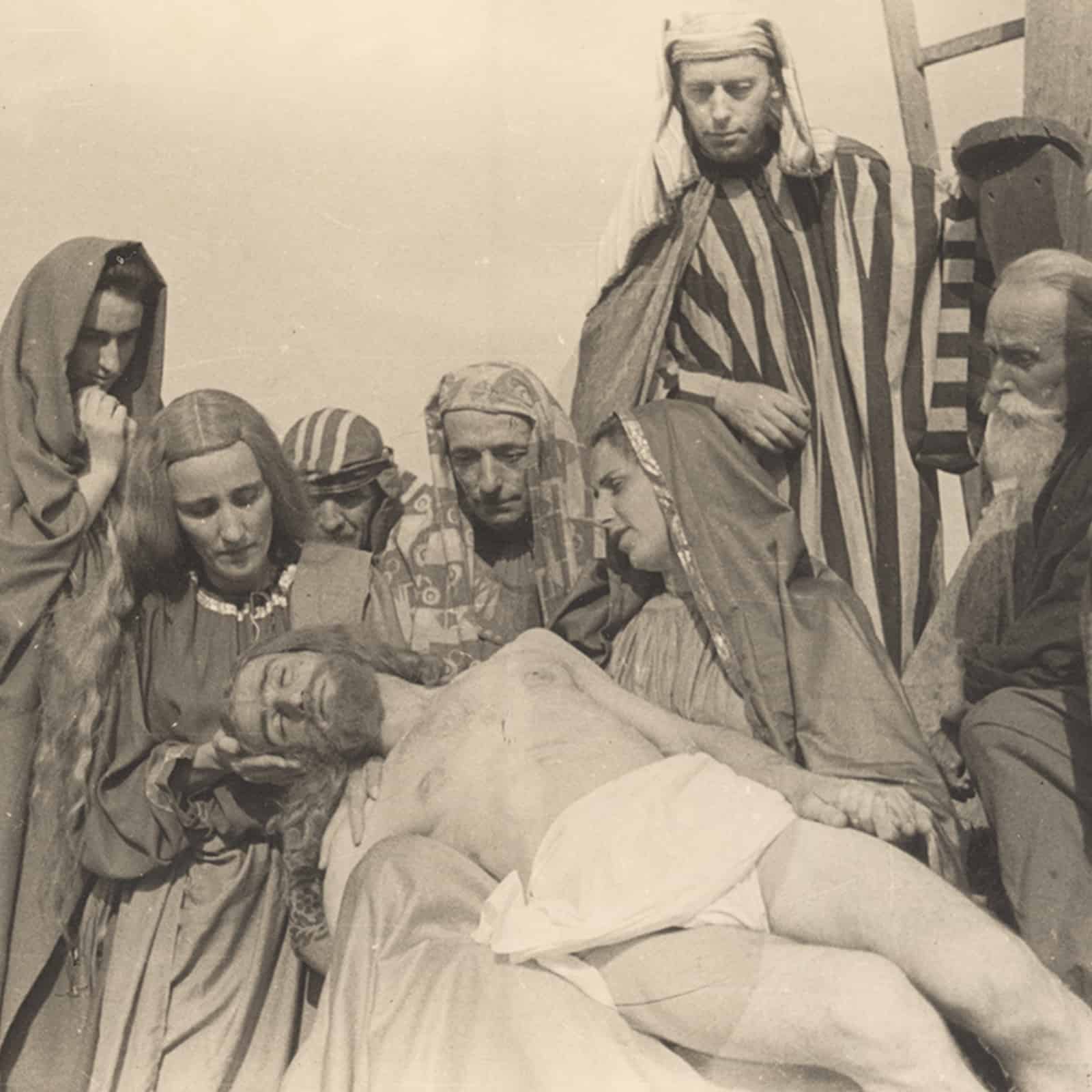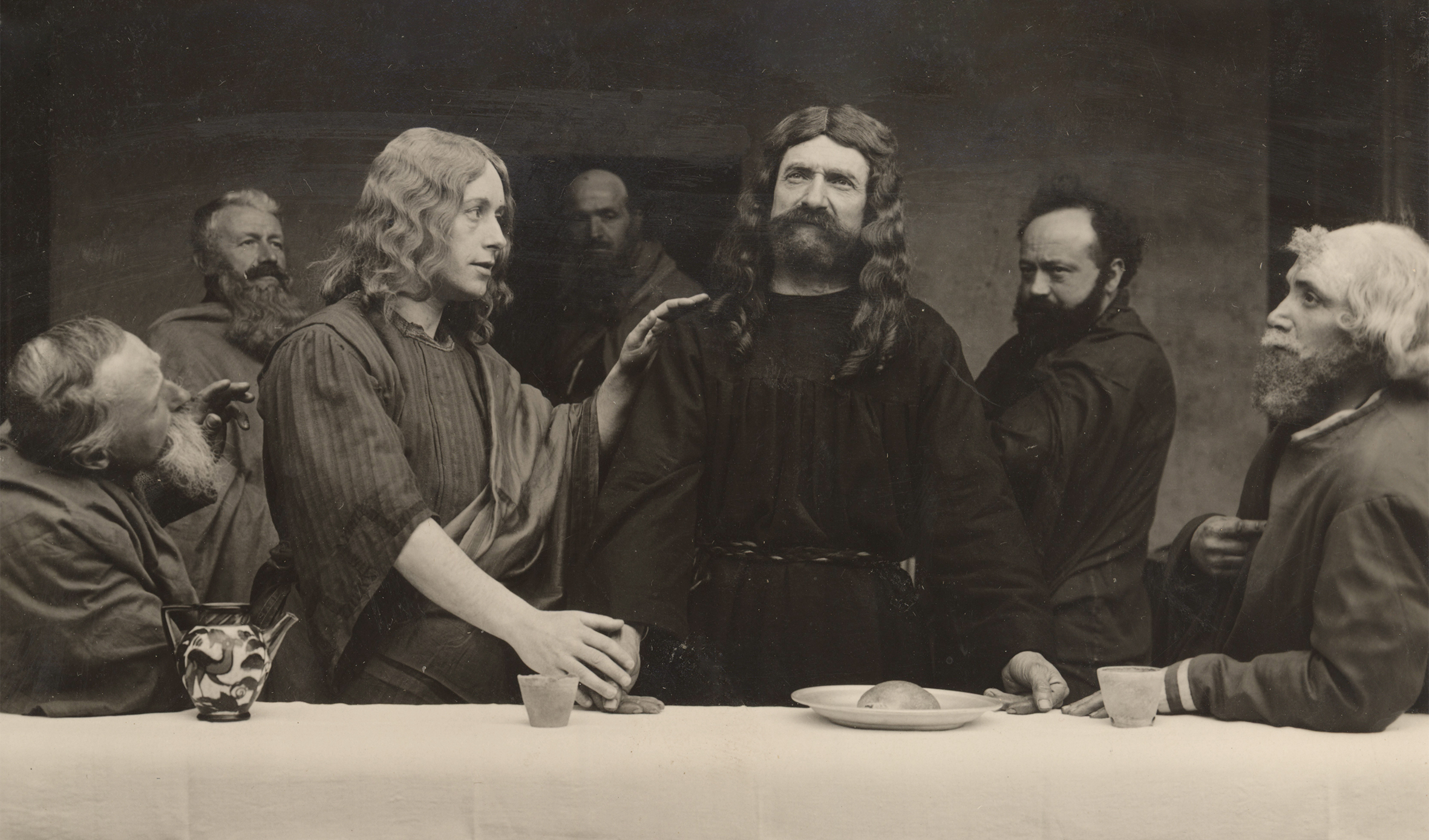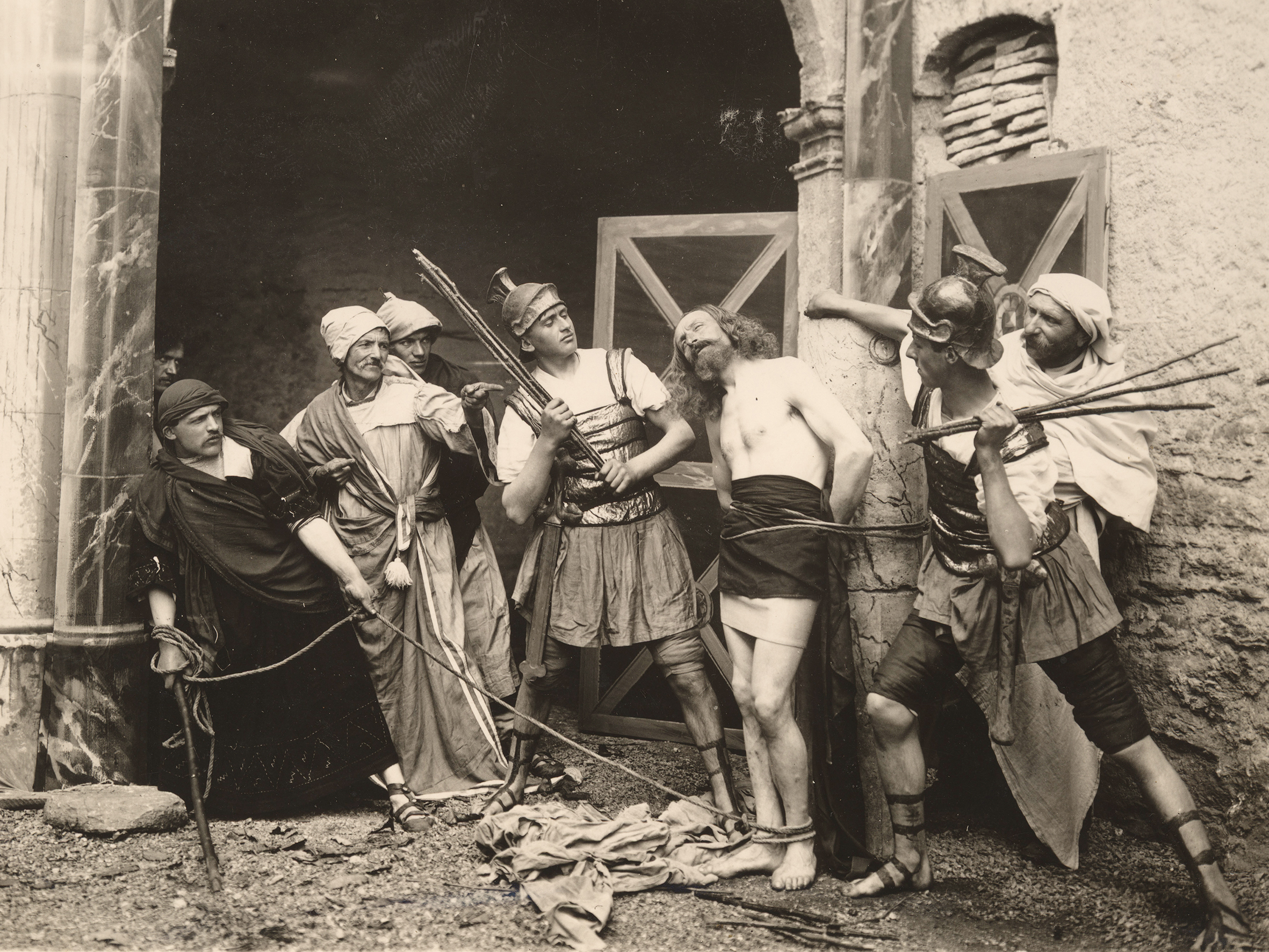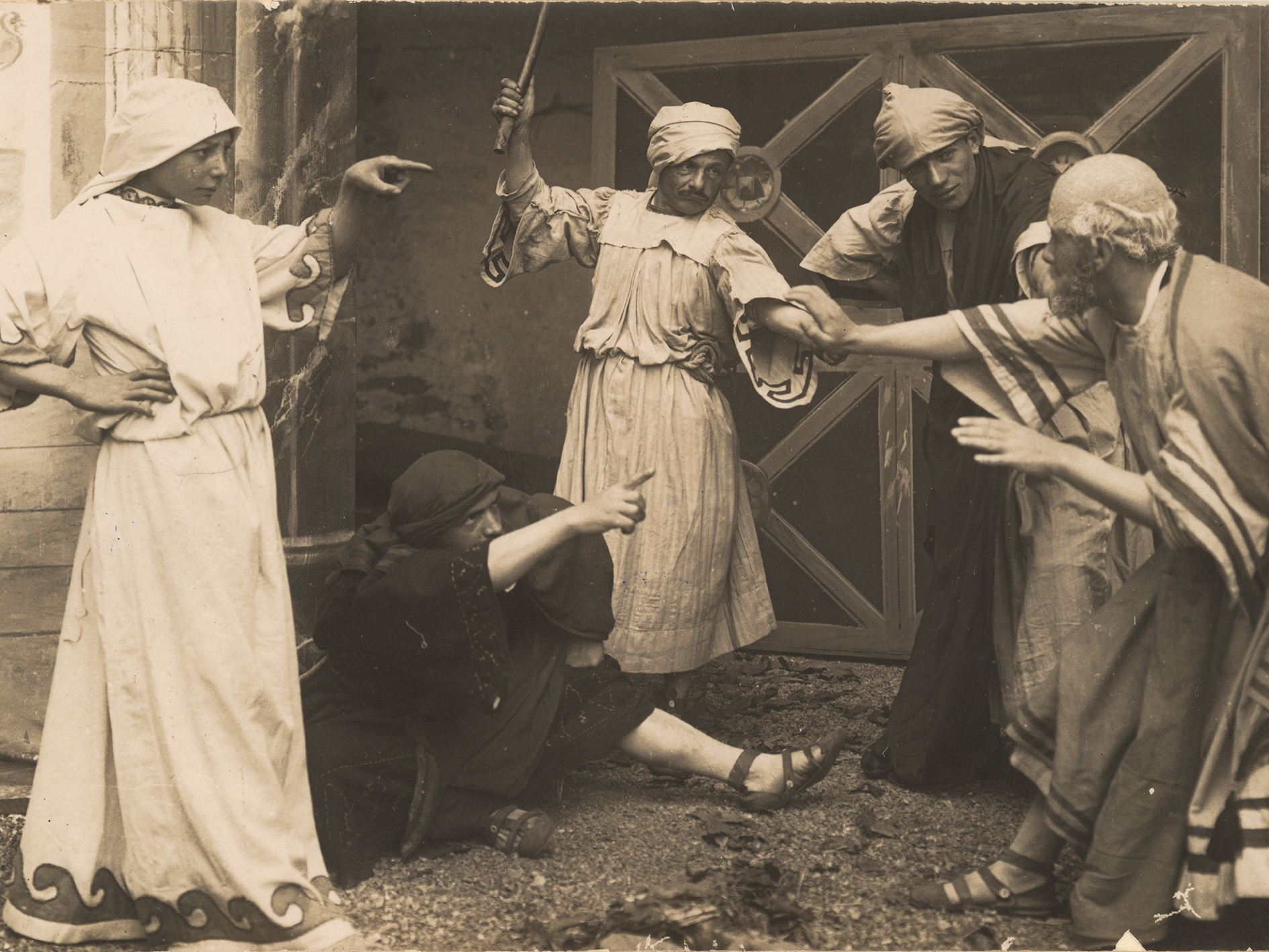A powerful commemoration coming from the past
The staging of the Passione di Sordevolo, in accordance with the popular tradition, celebrates the two hundred years of life in the 2015.
Still, several elements let us think to a former origin.
Here we’ll go back towards a possible past, therefore we won’t treat the period of the performances certified by reliable sources, played in sure dates, anyway during the XIX century.
The search of documents about the “first Passione” di Sordevolo has become similar to the quest of the Sangraal. However such a beginning, based on the finding of documentary evidences only, is unlikely a help to discover the real origin of it; on the contrary, it’ll add another date to the ones we already know. Furthermore it considers neither the cultural environment in Piedmont, and wider speaking of whole Italy, nor the strong religious identity of Sordevolo.
There are in Piedmont evidences of sacred plays, in particular about the Passion, performed in former time that the documented ones in Sordevolo, even in the fifteenth century. We know the dates of two Passion plays represented in Turin: 1463 and 1468. Another one, regularly documented, took place in Revello, near Saluzzo, between the years 1481 and 1486.

…Così a Sordevol, che con voce pia
rinnova or la passione del signore
e or son cent’anni già quasù fioria
ritorna il popol con devoto amore…
– 1914, prof. Agostino Mersi
In the Saint Stephan’s Chapter Archive in Biella we find a proof in the “Libro dei Conti del Can. Giacomo Carrarino” (Giacomo Carrarino’s Account Book) that in Biella, on July 4th, 1529, took place a play on Abraham’s life and on the flood that submerged Sodom and Gomorrah.
Angelo Stefano Bessone, historian of the local Church, tells us about a procession, called “Processione delle Angiolette” (Procession of “Angiolette”) organised by the Compagnia della Dottrina Cristiana, dating back 1572, composed by five-six hundred people, during the which “some scenes of the Old and the New Testaments” are performed. In the year 1783 it is banned by the bishop Viancini, since it was corrupted and considered by then devoid of any religious worth. This just to demonstrate that, contrary to what asserted by the historian Ricardo Adalgiso Marini in his essay “La Passione di Gesù Cristo in Sordevolo” dated 1904, some sacred plays took place in the Biellese land before the XVIII century.
Between the end of XV century and the beginning of the next one, the Compagnia del Gonfalone (Gonfalon Society) in Rom, performs a text of the Passion in the Colosseum. The text is printed in Rom for the first time in the years 1500-1501. This roman edition indicates that the text was composed by several people: the florentine Juliano Dati, Antonio Romano’s son, Bernardo and Mariano Perticappa”. Nevertheless, the great scholar of texts about the origin of Italian theatre in the Middle Age, Vincenzo De Bartholomaeis, is persuaded the three authors made a simple patching of former texts only.
There are several versions of this text, among all the one printed in Turin in the year 1728.
The writer, playwright and scriptwriter Pier Francesco Gasparetto writes that during the XVI century there is a great, unrepeated moment of life and mutual artistic expression …now big towns and small villages want their performance, the Christmas cycle and the Passion, the Last Judgement, the Miracles and the Life of Saints).
How can Sordevolo be extraneous to this movement of popular theatre, but meanwhile be able to build seven churches between the second part of the XVI century up to the beginning of the XVIII? And moreover to decorate the interiors with works of artistic value, showing not only a marked tendency to spend on religious purposes, as a result of a strong Christian faith and culture, but also a high level of artistic culture?
The first documentary evidence of sacred plays in Sordevolo is the Conversion of St. Augustine dating back 1777.
Such a performance could unlikely be improvised when not already part of a theatrical culture able to play a particular sacred text, surely not belonging to the religious folk tradition. We’re also informed by Delfino Orsi, who was a journalist, a man of letters, a historian and a critic of the Piedmont folk theatre, that in Sordevolo up to the half of the XIX century the” Last Judgement” and the “Resurrection” as well as the “Passion” were played. The first two plays call for “a complicate scenic layout divided in several different compartments” and have been given up on 1850, when people decided to perform only the “Passion”.

These facts, together with the ascertainment of a persistence of Jansenistic signs in the Passion played in Sordevolo during the XIX century, let us think the Passione was already performed during the XVIII century at least. These evidences come for sure from the history of Sordevolo, dating back XVIII century, where the presence of Jansenism is well documented in the parish library.
The photographs of the Passion dated 1866 and 1891, actually, well show Christ’s arms placed in accordance with the iconography of the “Jansenistic crucifix” showing “spring arms”, that is an asymmetrical position of not completely open arms, nearly to indicate the small number of people chosen to get in the Kingdom of Heaven .
As previously already said, Marini asserts that no sacred performances took place in the Biellese area before the XVIII century and fixes the date of the beginning on 1728, when the text of the “Passion” played in Rom during the XVI century by the Compagnia del Gonfalone in the Colosseum was published in Turin. The reason is, in the opinion of Marini, since the text played in Sordevolo is the one printed in Turin on 1728; he also says all texts of the “Passions” played in the area of Biella come from this one.
The “Passions “ Marini refers to were performed in Occhieppo, Andorno, Cavaglià, Romagnano and Mongrando.
The documented news about sacred performances in the area Biellese-Canavese vanish at the beginning of the XIX century. The oldest one concerns a play of the “Passion” dating back 1809 in the Castelnuovo Valley, Alto-Canavese area, certified by Costantino Nigra, who believes there was a production of the Passion in 1809.
With regard to Sordevolo, Marini refers that “the sole sure date, remembered by municipal documents, is 1816”, but this is not born out by any document.
The researcher Adalgisa Manza, also author of the text “Le rappresentazioni sacre nel Biellese” dated 1954, starting from the statement of Marini, has done a research in the local Archive of Sordevolo but hasn’t found evidences for these documents, anyway already considered as “undefined”.
To her experience I add my personal one. Writing my book ”Sordevolo e la sua Storia” I also had looked for these documents in the local Archive.
This work began with an examination of the current inventory to become later a systematic survey of all the records. The outcome has been the recovery of a sole folder containing documents about the Passion but they refer to statements of expenses and problems of public order for performances dating back beginning of the XX century; and actually they’re inside the folder entitled “Public Security”. Nevertheless, as Marini probably refers to the Archive of his time, 1904, and there have been meanwhile alterations, I also checked the inventories dating back 1861, 1872, 1874, kept in the present-day Archive. No evidences about the Passion are present in these records. The research made by Adalgisa Manza is accurate, therefore I can join with her saying that these chimerical and unsettled “municipal documents” are “the ingenuous dodge thought out to increase believability to the verbal evidences”.
As previously said, the study of the documental dates we know is not the right way to follow, in order to discover a reasonable beginning of the religious and popular theatre in Sordevolo; on the contrary the reconstruction and the right interpretation of literary documents and theatre events only, related to the cultural environment of that time, at least the XVIII century, can enlighten us on the antiquity of the sacred theatre in Sordevolo.

Now we are forced to go back to the text printed in Turin on 1728, a copy of which is kept, together with other texts, among which another edition of the same text printed in Venice on 1780, in the Historical Archive of the Associazione Teatro Popolare di Sordevolo, together with other documents, one of which is another edition of the same document printed in Venice in 1780.
Does the presence of this text mean it is the one the Passione di Sordevolo comes from?
Surely it is a challenging clue, before of all as Orsi, member of the audience during the performance dated April 12th, 1891, writes a book entitled “La Passione di Sordevolo” and asserts that edition played in Sordevolo is the one printed in Turin, and this one shows some light variations to the first roman edition.
Opinion also confirmed by Marini on 1904.
Another dramatist, theatre critic and journalist, Renato Simoni, makes in the 1934 the opposite conjecture, that is the text printed in Turin coming from Sordevolo.
This last hypothesis brings us back to the words written by Orsi at the beginning of the a.m. work: since a long time ago this village (Sordevolo) perpetuates the tradition of the sacred drama, whose origin cannot be surely ascertained; but without any doubt we can affirm it is aged several centuries.
These words are strongly denied by Marini.
Now there’s another question: Is the text really the one issued in Turin in the year 1728?
Having examined the text followed in Sordevolo, both Manza on 1954 and Gasparetto on 2000 agree there are several and strong differences between the two.
Without a philological rebuilding of the text, surely interesting, the conclusion made by the two scholars is “The Passione di Sordevolo is the same one played in Rom during the XVI century by the Compagnia del Gonfalone in the Colosseum.
Gasparetto writes these Turin changes are generally an advantage for incisivity and rythm of the play and let us suppose they’re a suggesting link with the old texts played in Colosseum.
Manza, she too persuaded of a tie with the original version played in Rom, referring to the performances she saw at her time, adds: “It is still a probative element, and with a certain importance in favour of our hypothesis, the anachronistic presence of the “dark hooded people” (in Sordevolo known as “Pilgrims”, their presence was cancelled since 1970) during the last scenes of the Passione di Sordevolo: death and burial of Christ. In-fact the most important Devotions brought in Colosseum were two: the play of the Passion of Christ and the processions of the Maundy Thursday. Therefore the Devotion in Sordevolo becomes, in its last scenes, a visual synthesis of feelings referred by those old members of the audience in Rom during the Holy Week; and in this way ‘its several times centennial antiquity’ argued by Orsi is defended”.
And so we go back to the question: Who has brought in Sordevolo the text of the Passion? Some authors made a first hypothesis, asserting the Passion was introduced in Sordevolo by the Trappist in the last years of the XVIII century. In consequence of the researches I made in order to write “La Storia della Trappa” I can exclude this idea. At first as they were strict enclosed monks with no possibility to get in touch with other people; then as they could not have good relations with the local community due to the fact their presence in Sordevolo was imposed by the Savoy against the will of the Town Council.
Manza affirms an important rule could have been played by the Ambrosetti in consequence of their strong contacts with Turin and Rom.
By mean of the historian Valerio Castronovo, we certainly know they represent the most important family of Biella belonging to the upper class of wool manufacturers. Since 1691 they’re official supplier of wool cloth for the Savoy’s Army. They have contact with Rom, where they buy wool, but their importance spreads out only during the XVI and XVIII century. We can’t find their name in the “Elenco dei capi famiglia e proprietari d’immobili di Sordevolo nell’anno 1578” published by the historian of Sordevolo, Marco Neiretti.
But on the a.m. list we find the family Martano, their ancestor. And on the same list there are the Vercellono, later (XVII century) become Vercellone, another big family with an important rule in the history of Sordevolo, “originated from the upper middle class of professionals and civil/ecclesiastical bureaucrats” as Castronovo says.
On the same list we also find the Bruco or Brucco or Brucho yet, at first vassals of the Bishop in Vercelli, later officials by the Savoy State and at the end counts of Sordevolo.
All of them were families with wide contacts and frequentations.

We can also add the presence of the Girello family, builder, during the XVII century, of the Holy Trinity and S.Charles Oratory, where several valuable art works were kept. And we can still add the presence on the list of the family Petiva, able to get in touch with the Camaldolese monks in order to help their settlement in the St. Grato Oratory, eventually not happened because of the opposition of the local Council.
Therefore Sordevolo has many chances to relate in different periods with cultural and religious parties also if sometimes far from its area.
Manza, that at first backs the Ambrosetti hypothesis, without a complete evaluation of the time aspect, referring to the several occasions when in Rom the Devotions in Colosseum took place, widens the field of chances, writing “it is not unlikely that some pilgrims arrived in those years into the Flavio Theatre were from Sordevolo and that they brought back to their village, together with enthusiasm, also a desire of emulation”.
Finally we have not to forget the relationship of the local Brotherhoods with Rom.
Particularly important is the one of the St. Lucy Confraternity in Verdobbio.
On the relation made during the episcopal visit in 1731 is written that on November 29th, 1680 the Confraternity of Verdobbio joined the Arciconfraternita del Gonfalone in Rome, just the one of the Devotions in Colosseum. It was obviously not a sudden event; on the contrary the result of long lasting contacts. It is possible the Confraternities met through the drama of the Passion and then aggregated.
The brotherhood’s name St.Lucy, as well, is not casual, on the contrary bound to the Arciconfraternita del Gonfalone; in fact there were in Rom two churches strictly tied to it; the one, “St.Lucy of the Gonfalon”, also called “St.Lucy the new”; the other, the Oratory of the Gonfalon, built on the ruins of the old Church of St.Lucy, called “St. Lucy the old”.
The possible habitual visiting in Rom of the Sordevolo community has probably put it in the conditions to come into possession not only of the roman text of the “Passion”, but also to be acquainted of the scene plant. Therefore, referring to the analysis of the textual and scenic elements proposed by Gasparetto and Manza, we could assume that the first plays took place in Sordevolo already during the XVI century, when the visual images of the roman Devotions are very clear in the visitors’ eyes yet.
Nevertheless, as already told, a strong popular tradition in Sordevolo put the first play on 1816, in accordance with the date suggested by Marini.
But all what aforesaid let think that this powerful remembrance has a longer, but unfortunately unwritten, history so that we can agree with what Orsi wrote in 1892 about “the antiquity several time centennial” of the Passione di Sordevolo.
Giuseppe Silmo
The text is extracted from the book “Sordevolo e la sua Storia” written by Giuseppe Silmo.


